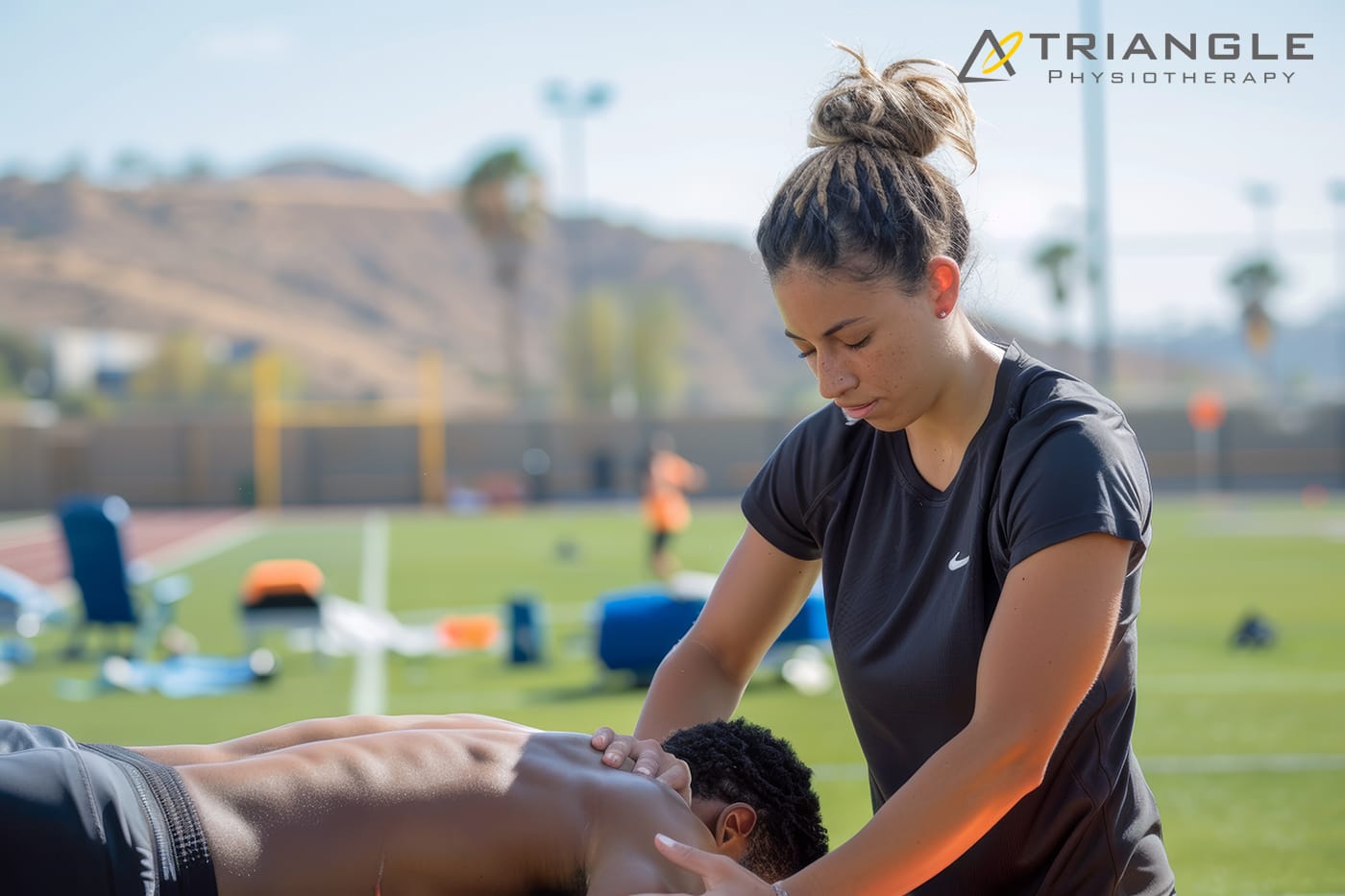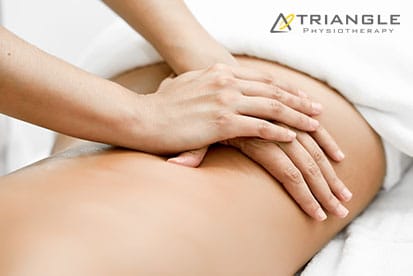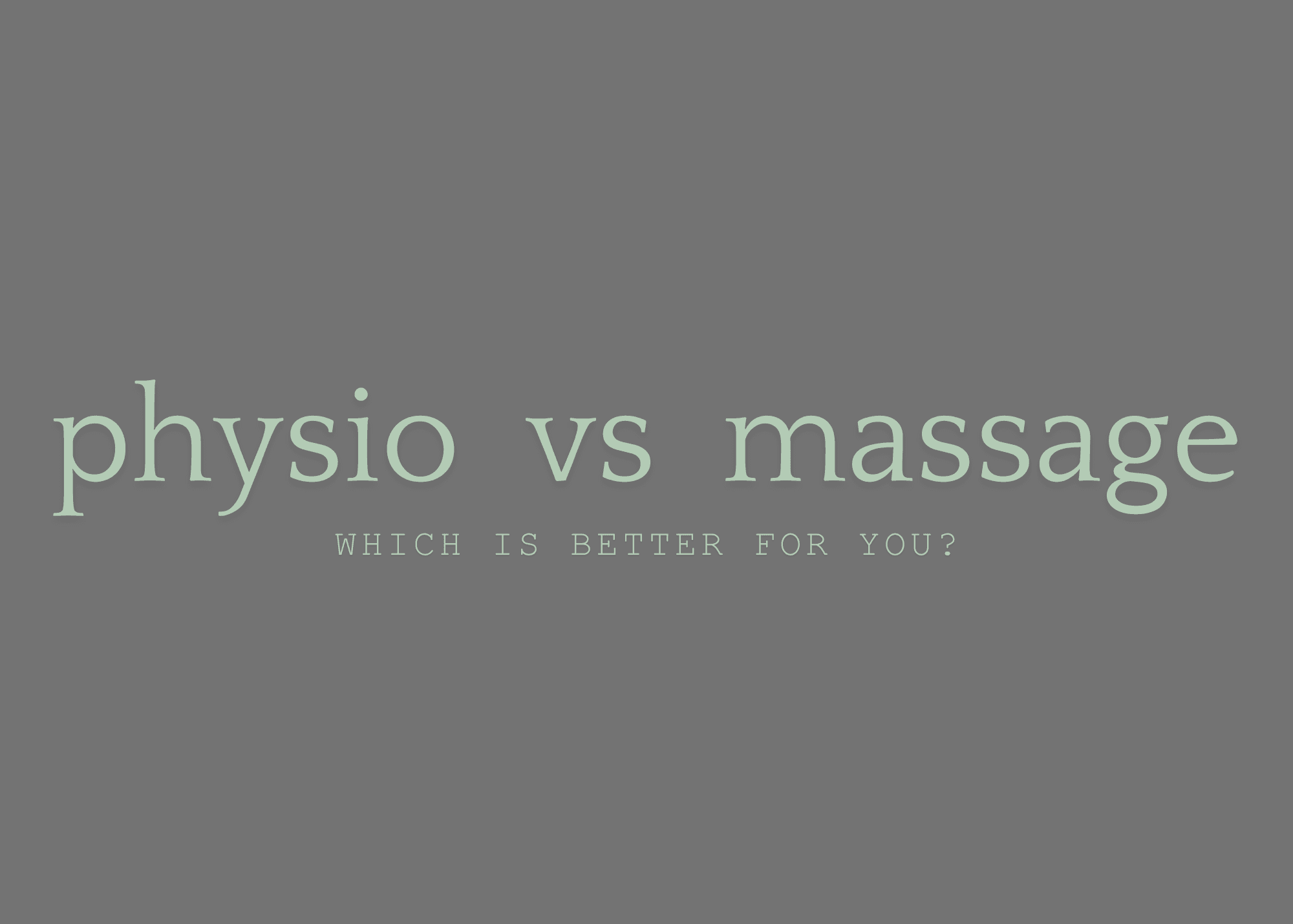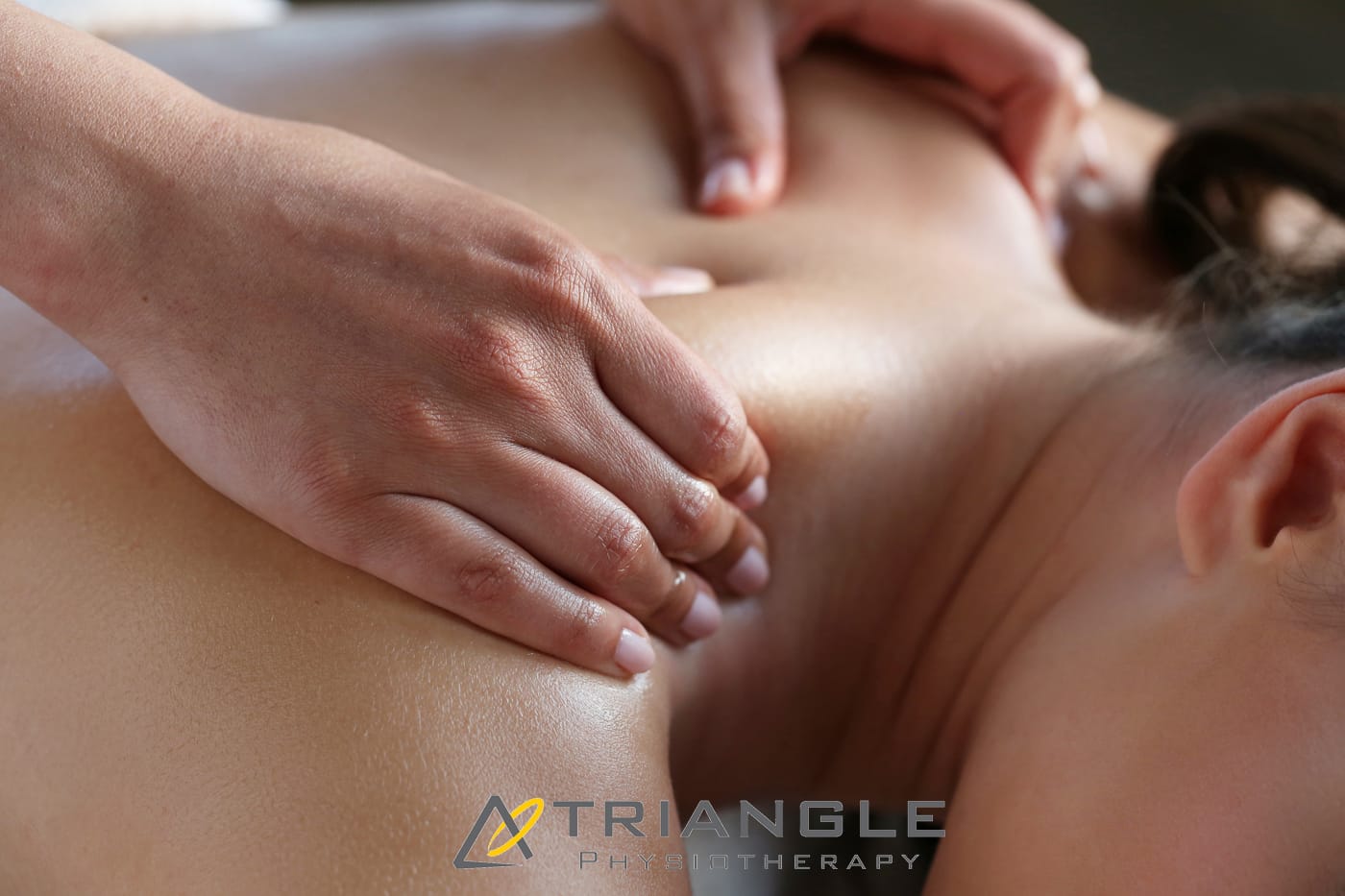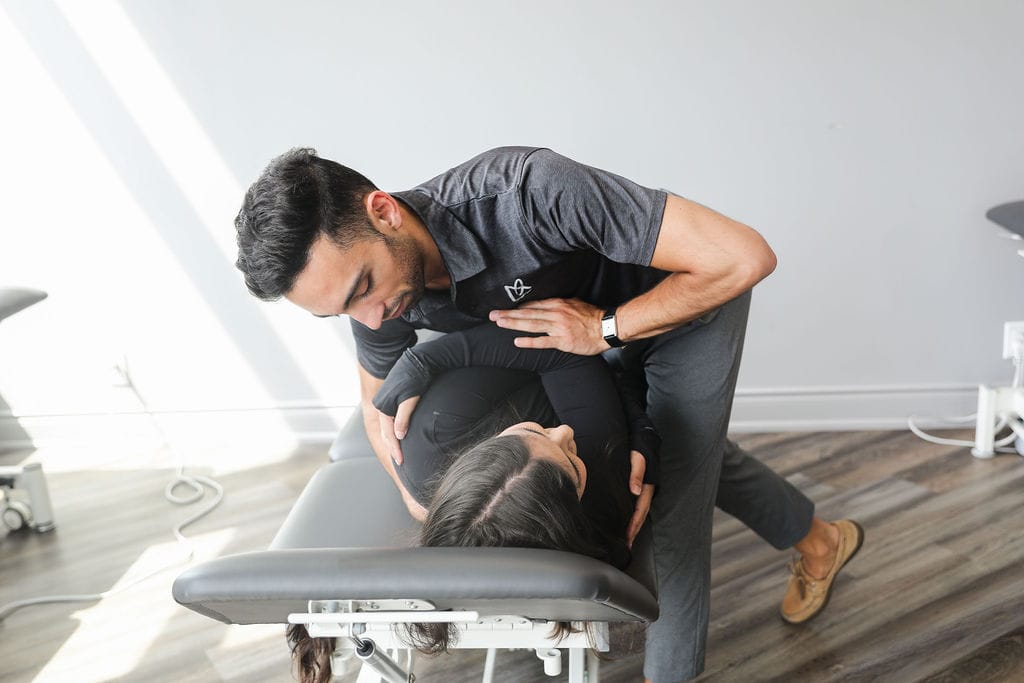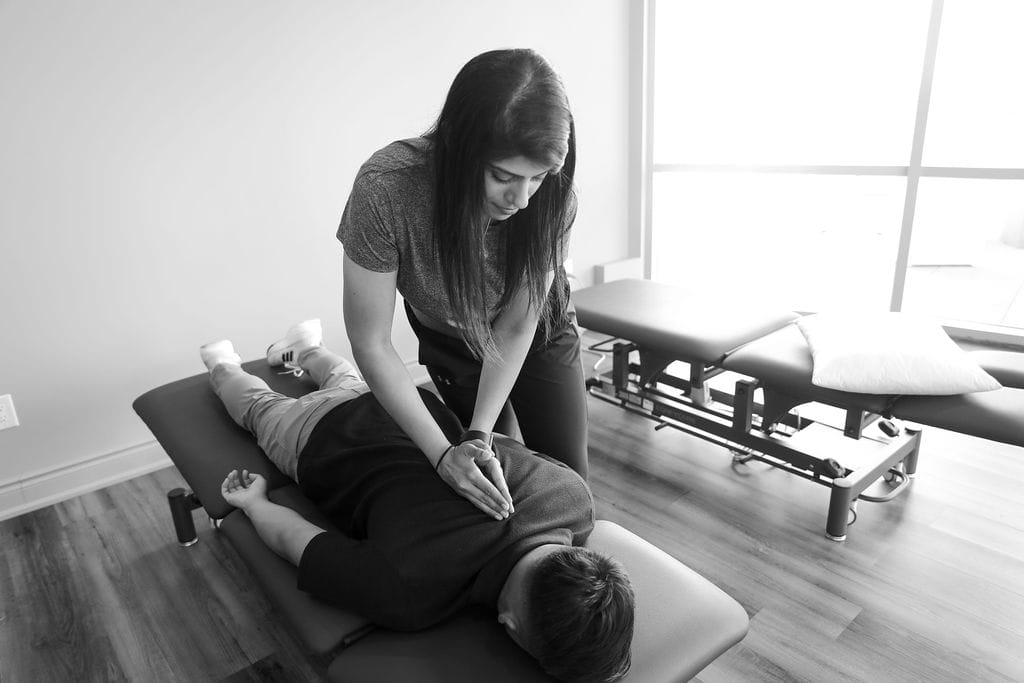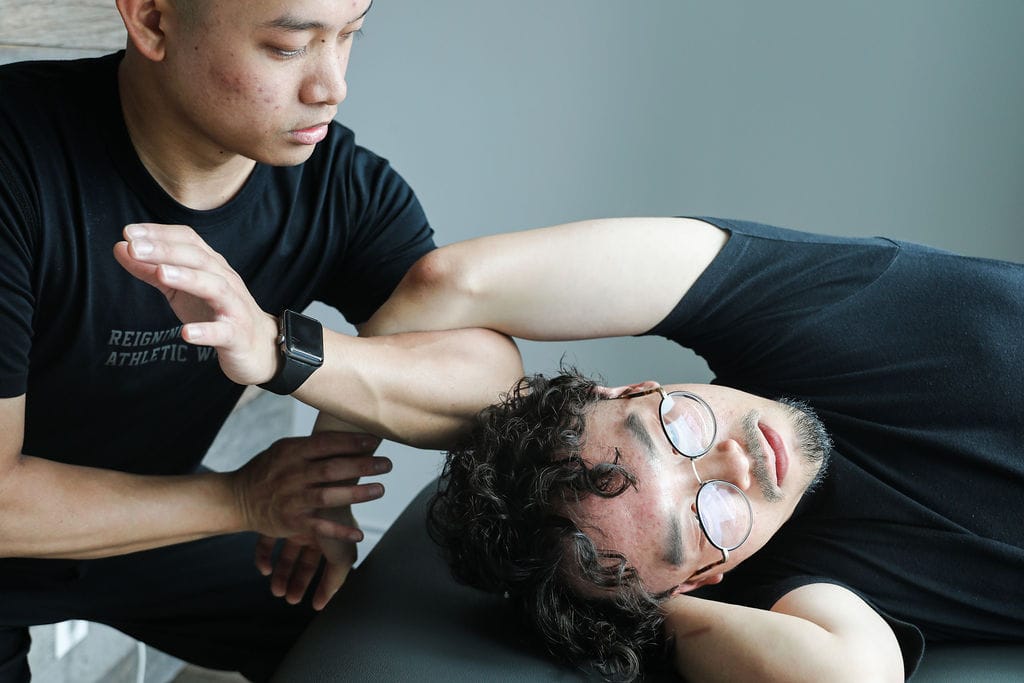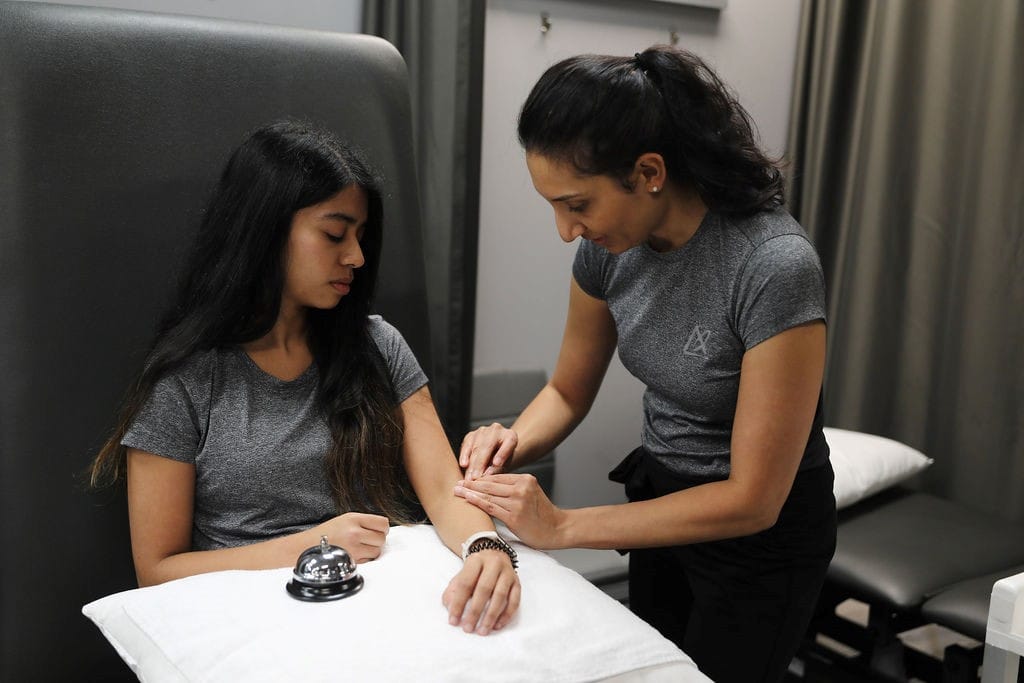When it comes to therapeutic massage, two popular techniques often come up: sports massage and deep tissue massage. While they share some similarities, they serve different purposes and are designed for distinct needs. Understanding the nuances between the two can help you choose the right massage for your goals, whether you’re an athlete or simply seeking relief from tension. The massage therapists at Triangle Physiotherapy use techniques that can target the muscles to help reduce your pain and improve your ability to play the sports you love as well as enhance your well-being.
Understanding the Techniques
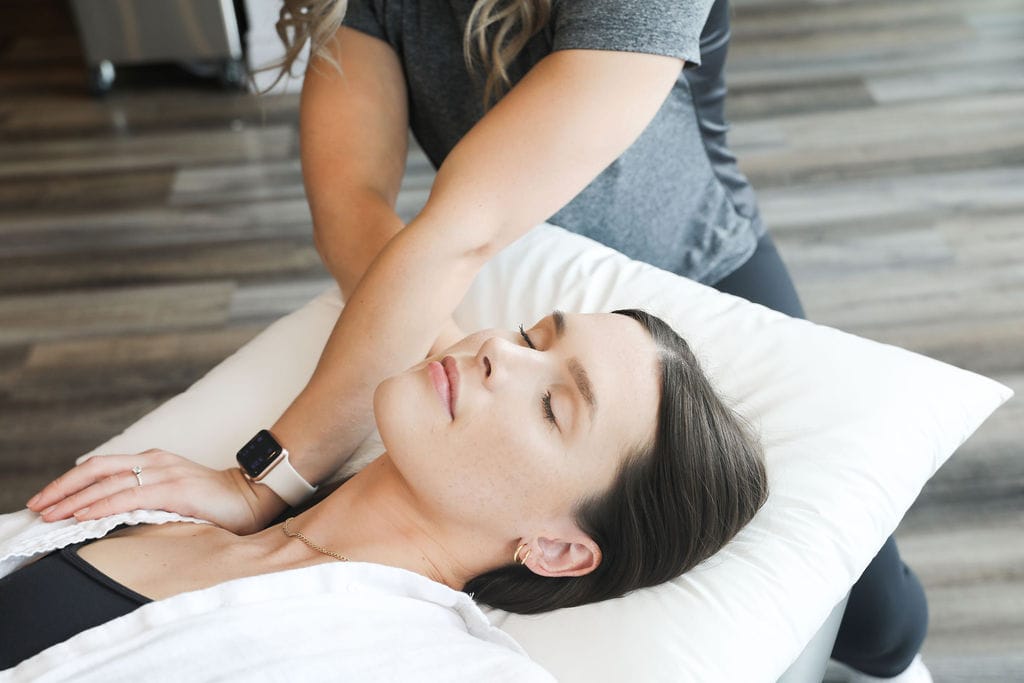
Sports Massage
Sports massage is specifically tailored for athletes, focusing on enhancing performance, preventing injuries, and aiding recovery. It incorporates various techniques to address the specific needs of athletes at different stages of training and competition. Whether you’re preparing for a big race or recovering from a strenuous workout, sports massage can be a valuable addition to your routine.
Deep Tissue Massage
Deep tissue massage, on the other hand, is a broader technique that targets the deeper layers of muscle and connective tissue throughout the body. It aims to alleviate chronic pain, tension, and stiffness by applying sustained pressure on targeted areas. While deep tissue massage can benefit anyone, it’s particularly effective for those who experience long-term muscle tension or discomfort.
Key Differences
Purpose and Focus
The primary difference between sports and deep tissue massage lies in their purpose. Sports massage is focused on improving athletic performance and recovery, using techniques tailored to the athlete’s specific needs. It may involve stretching, trigger point therapy, and even techniques to stimulate blood flow.
Conversely, deep tissue massage targets specific areas of chronic pain and tension. It works through layers of muscle and fascia to release knots and relieve tightness, making it ideal for individuals dealing with ongoing discomfort rather than performance enhancement.
Techniques Used
Both massages utilize pressure and manipulation, but the techniques may vary significantly. Sports massage often employs:
- Compression techniques: To stimulate circulation and reduce muscle soreness.
- Stretching: To improve flexibility and range of motion.
- Cross-fiber friction: To break down scar tissue and promote healing.
Deep tissue massage, in contrast, focuses on:
- Slow, deep strokes: To reach the deeper layers of muscle.
- Pressure points: To release tension in specific areas, often requiring more intensity.
- Kneading: To work out knots and alleviate chronic tightness.
Ideal Recipients
Sports massage is primarily designed for athletes or active individuals who engage in regular physical activity. It’s beneficial before events to prepare muscles or after workouts to speed recovery. Athletes of all levels, from recreational runners to professional players, can gain from this specialized approach.
Deep tissue massage, however, is suitable for anyone experiencing chronic pain or tension, regardless of their activity level. It’s often recommended for individuals who sit for long periods, have physically demanding jobs, or suffer from conditions like arthritis or fibromyalgia.
FAQs
Can I get a sports massage if I’m not an athlete?
Absolutely! Sports massage can benefit anyone with muscle tension or who engages in physical activities, regardless of their athletic level.
Is deep tissue massage painful?
Deep tissue massage can be intense, especially if you have significant muscle tension. However, communication with your therapist can help manage discomfort.
How often should I get a massage?
The frequency of massage depends on individual needs and goals. Athletes might benefit from more frequent sessions, while those seeking relief from chronic pain may require regular visits to maintain comfort.
Can I use both types of massage?
Yes! Many people find that incorporating both sports and deep tissue massage into their routine addresses different needs effectively.
Choosing between sports massage and deep tissue massage ultimately depends on your individual needs and goals. While sports massage focuses on performance and recovery for athletes, deep tissue massage aims to alleviate chronic tension and discomfort for a broader audience. Understanding these differences can help you select the most beneficial approach for your well-being, ensuring you receive the right care for your body. Whether you’re looking to enhance your athletic performance or simply unwind from daily stresses, both techniques offer unique advantages that can enhance your overall health.
Looking for a Massage Therapist? Call or book your appointment online.
Triangle Physiotherapy has 8 locations in the Greater Toronto Area with registered massage therapists that can help you perform at your best! Book your Appointment today!
References:
https://www.physio-pedia.com/Rehabilitation_in_Sport
https://www.physio-pedia.com/Massage
For athletes, whether they’re professional competitors or weekend warriors, massage therapy isn’t just a luxury—it’s a crucial part of their training and recovery routine. While the soothing effects of a massage might seem like a simple indulgence, its benefits extend far beyond relaxation.
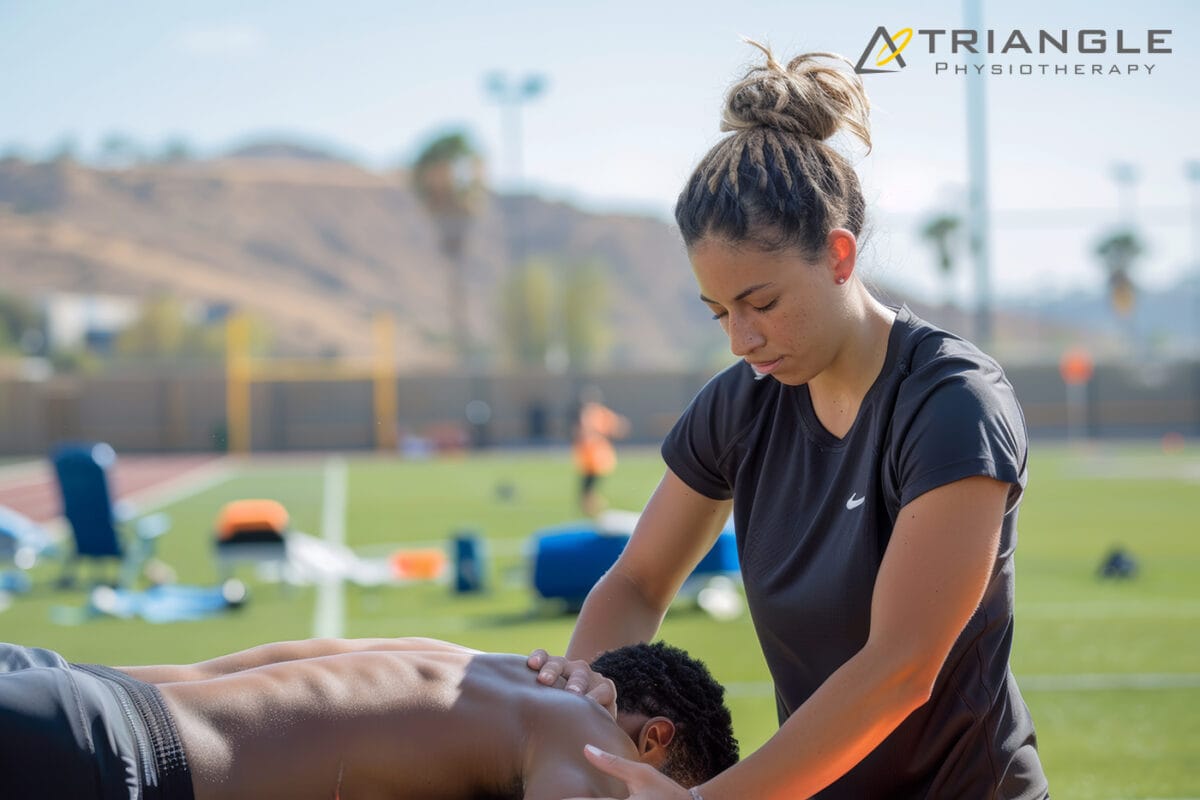
Here are five compelling reasons why athletes should incorporate massage therapy into their regimen:
1. Enhanced Recovery and Reduced Muscle Soreness
After an intense workout or a grueling competition, muscles can feel sore and fatigued. This is where massage therapy shines. By increasing blood flow and enhancing circulation, massage helps to deliver essential nutrients and oxygen to tired muscles, facilitating quicker recovery. Additionally, it helps to flush out metabolic waste products like lactic acid, which can accumulate and contribute to soreness. Regular massages can reduce muscle stiffness and speed up the recovery process, allowing athletes to get back to training faster and more efficiently.
2. Injury Prevention and Improved Flexibility
Injuries are an unfortunate part of an athlete’s life, but many can be prevented with proper care. Massage therapy plays a critical role in maintaining flexibility and preventing injuries. By working on tight or imbalanced muscles, massage helps to release tension and improve range of motion. This not only reduces the risk of strains and sprains but also helps athletes maintain proper biomechanics, which is essential for both performance and injury prevention.
3. Improved Performance and Reduced Muscle Tension
Massage therapy is not just about recovery; it also contributes to enhanced performance. By addressing muscle tension and promoting relaxation, massage can improve an athlete’s overall sense of well-being and focus. This relaxation helps in reducing the mental and physical stress that can negatively impact performance. Furthermore, a well-tuned muscle system can lead to better coordination, agility, and strength, giving athletes a competitive edge.
4. Stress Relief and Enhanced Mental Clarity
The pressures of training, competition, and performance expectations can take a toll on an athlete’s mental health. Massage therapy provides an opportunity for relaxation and stress relief. The act of being touched and the calming environment of a massage session can reduce levels of the stress hormone cortisol while boosting the release of endorphins, which are natural mood lifters. This not only helps athletes manage stress more effectively but also contributes to better mental clarity and focus, which are essential for peak performance.
5. Better Sleep Quality
Quality sleep is vital for recovery, performance, and overall health. However, athletes often struggle with sleep issues due to the physical demands of their training and competitions. Massage therapy can improve sleep quality by promoting relaxation and reducing physical discomfort that might interfere with rest. Enhanced relaxation and reduced muscle tension can lead to deeper, more restorative sleep, which is crucial for muscle repair, cognitive function, and overall well-being.
Incorporating Massage Therapy into Your Routine
To reap the maximum benefits of massage therapy, it’s important for athletes to incorporate it into their regular training regimen. Working with a skilled therapist who understands the specific needs of athletes can make a significant difference. Whether it’s a post-workout recovery session, a pre-competition tune-up, or a routine maintenance massage, finding the right type of massage and frequency that works best for your body can help you achieve optimal performance and maintain overall health.
In conclusion, massage therapy offers a wealth of benefits for athletes, from speeding up recovery and preventing injuries to enhancing performance and improving mental clarity. By integrating massage into their training and recovery routines, athletes can better support their physical and mental well-being, paving the way for sustained success and peak performance.
Massage Therapy Mississauga
We have 2 locations with massage therapists in Mississauga to help you.
Massage Therapy has Many Stress-Relieving Benefits.
In today’s fast-paced world, stress has become a common issue for many people. Whether it’s work-related pressure, personal challenges, or the general hustle and bustle of daily life, stress can have a significant impact on both physical and mental health. One effective way to combat stress is through massage therapy.
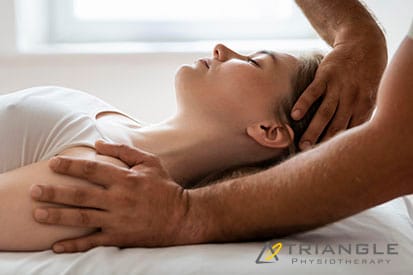
Here are three ways massage therapy can help reduce stress:
1. Physical Relaxation
One of the most immediate benefits of massage therapy is physical relaxation. Massage helps to relax tense muscles, reduce pain, and improve circulation. This physical relaxation can alleviate stress-related muscle tension, which is a common physical manifestation of stress. When the body is relaxed, it sends signals to the brain that help to reduce overall stress levels.
Massage techniques such as Swedish massage, deep tissue massage, and hot stone massage are particularly effective at promoting muscle relaxation. These techniques involve kneading, pressing, and rubbing the muscles to release tension and knots. As the muscles relax, blood flow improves, which helps to deliver oxygen and nutrients to tissues while removing toxins. This not only alleviates physical discomfort but also promotes a sense of well-being and relaxation.
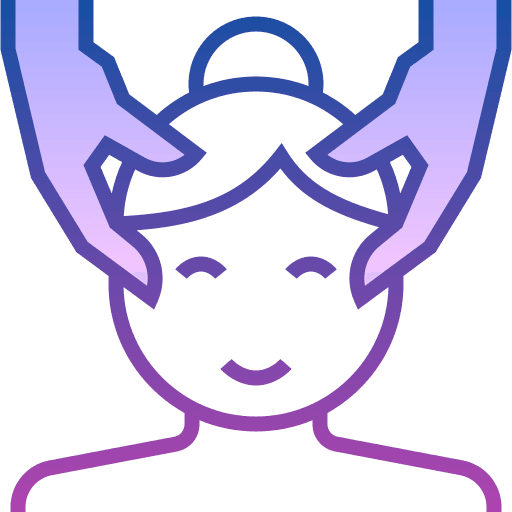
2. Reduction of Stress Hormones
Massage therapy can also help regulate the body’s stress response by affecting hormone levels. Studies have shown that massage therapy can lower the levels of cortisol, a hormone that the body releases in response to stress. High levels of cortisol are associated with various negative health effects, including anxiety, depression, and sleep disturbances.
In addition to lowering cortisol levels, massage therapy can increase the production of serotonin and dopamine. These neurotransmitters play key roles in mood regulation and overall feelings of happiness and well-being. Increased levels of serotonin and dopamine can help combat the effects of stress, leading to a more positive outlook and improved mental health.
3. Improved Sleep Quality
Stress often interferes with sleep, leading to a cycle of sleep deprivation and increased stress. Massage therapy can help break this cycle by promoting relaxation and reducing insomnia. Regular massage sessions have been shown to improve sleep quality by enhancing the body’s production of serotonin and melatonin, hormones that regulate sleep.
Better sleep allows the body and mind to recover from the daily stresses and challenges, leading to improved overall mental health and resilience against stressors. With regular massage therapy, individuals can experience more restful and restorative sleep, which in turn helps to reduce stress and improve their overall quality of life.
Click here to book an appointment with a massage therapist at one of our eight locations.
- Massage Therapy Etobicoke – Triangle Physiotherapy Etobicoke
- Oakville Massage Therapy Clinic – Triangle Physiotherapy Oakville
- Massage Therapy North York – Triangle Physiotherapy North York
- Mississauga Massage Therapy Clinics – Triangle Physiotherapy Mississauga
- Downtown Massage Therapy Clinics – Triangle Physiotherapy King West
- Uptown Massage Therapy Clinics – Triangle Physiotherapy Lawrence Park
- Massage Therapy Clinic Downtown Toronto – Triangle Physiotherapy Queens Quay
- Massage Therapy Clinics Mississauga – Triangle Physiotherapy Erin Mills
Massage therapy is an excellent way to reduce stress and improve overall well-being. If you’re seeking complementary treatments like massage therapy or physiotherapy in Etobicoke, Oakville, North York, Toronto, Lawrence Park, Queens Quay, Erin Mills, Mississauga, or Liberty Village, experienced physiotherapists are available to help you achieve better health and relaxation.
The choice between physiotherapy and massage therapy depends on your specific needs, goals, and health conditions. Here’s a detailed comparison to help you decide which might be better for you:
Physiotherapy
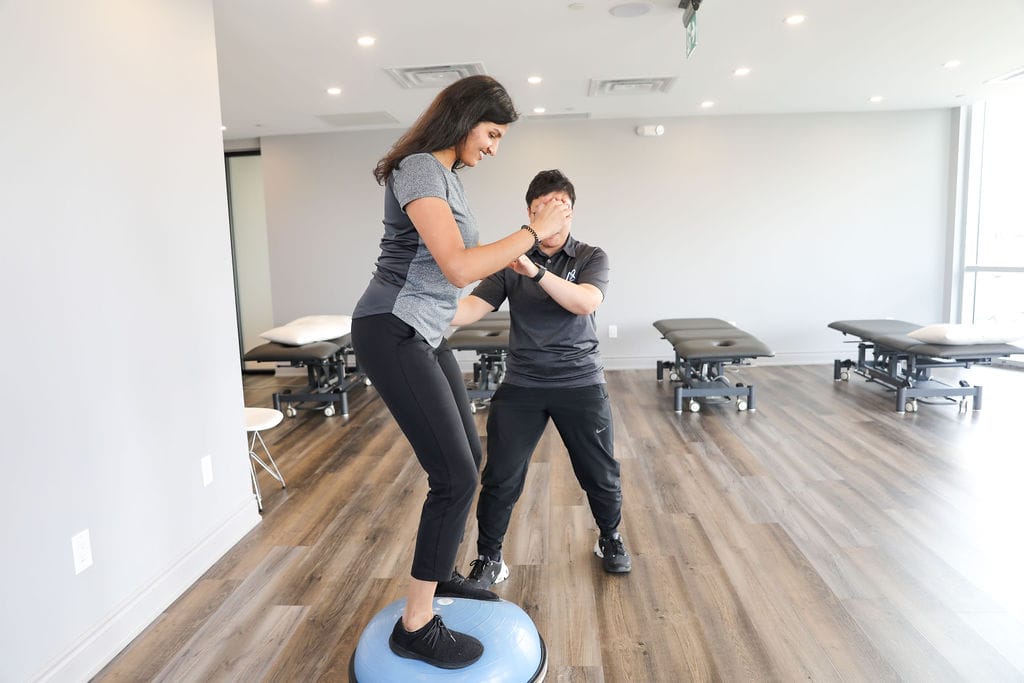
What it is:
- A healthcare profession focused on diagnosing, managing, and preventing movement disorders.
- Uses exercises, manual therapy, education, and modalities like ultrasound and electrical stimulation.
Benefits:
- Rehabilitation: Effective for recovering from injuries, surgeries, and chronic conditions like arthritis.
- Pain Management: Addresses the root cause of pain through various techniques and exercises.
- Improved Mobility: Helps restore function and movement, particularly after injury or surgery.
- Preventive Care: Offers strategies to prevent future injuries or manage chronic conditions.
- Customized Treatment: Tailors plans based on individual assessments and needs.
Common Conditions Treated:
- Musculoskeletal injuries (e.g., sprains, fractures)
- Neurological conditions (e.g., stroke, multiple sclerosis)
- Cardiopulmonary issues (e.g., chronic obstructive pulmonary disease)
- Post-surgical rehabilitation
Massage Therapy
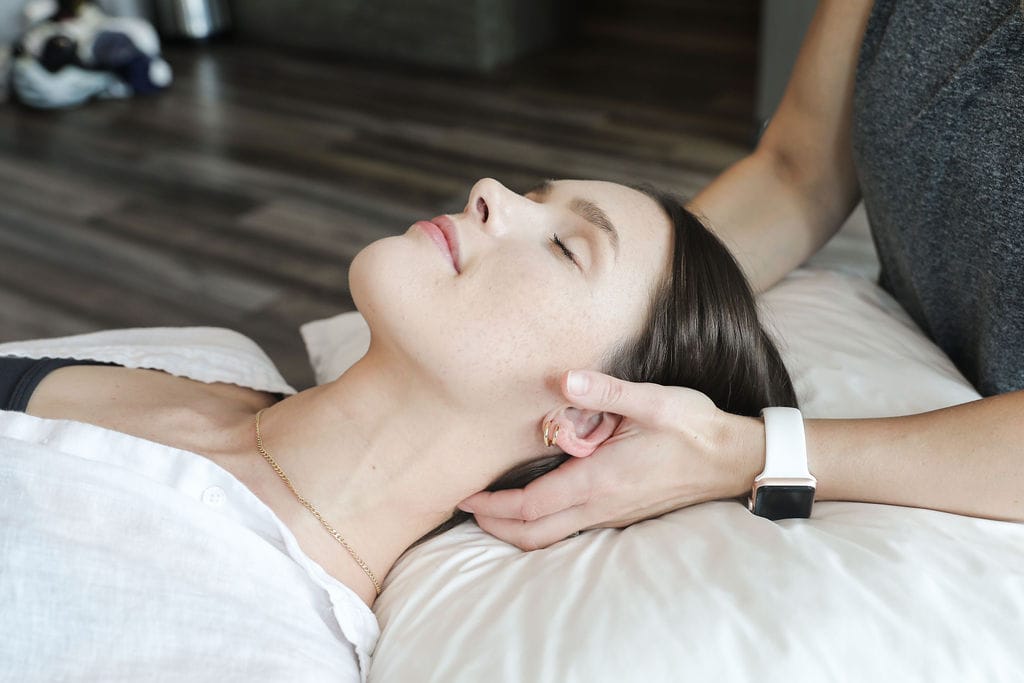
What it is:
- A practice involving the manipulation of soft tissues (muscles, tendons, ligaments) to enhance well-being.
- Uses techniques like stroking, kneading, and applying pressure.
Benefits:
- Relaxation: Promotes overall relaxation and stress relief.
- Pain Relief: Alleviates muscle tension and pain.
- Improved Circulation: Enhances blood flow, which can aid in healing.
- Flexibility: Increases range of motion and reduces stiffness.
- Mental Health: Can improve mood and reduce symptoms of anxiety and depression.
Common Conditions Treated:
- Muscle tension and soreness
- Stress-related conditions
- Chronic pain (e.g., back pain, fibromyalgia)
- Sports injuries
- Headaches and migraines
Which is Better for You?
- For Injury Rehabilitation or Chronic Conditions:
- Physiotherapy is typically more suitable as it provides a structured approach to recovery, addressing the underlying causes of your condition.
- For Stress Relief and Muscle Tension:
- Massage Therapy can be highly effective if your primary goal is relaxation and relief from muscle tightness.
- For Pain Management:
- Both can be effective, but the choice depends on the cause of the pain. Physiotherapy is often better for pain related to injury or chronic conditions, while massage therapy can be great for muscle-related pain.
- For Improved Mobility and Function:
- Physiotherapy focuses on restoring function and movement, making it the better choice for mobility issues.
- For Preventive Care:
- Physiotherapy provides long-term strategies to prevent injuries and manage chronic conditions.
- For Overall Well-being and Relaxation:
- Massage Therapy is beneficial for enhancing general well-being, reducing stress, and promoting relaxation.
Combination of Both:
- In some cases, a combination of physiotherapy and massage therapy can be beneficial. For example, physiotherapy can address the underlying issues, while massage therapy can help manage symptoms and improve overall well-being.
Conclusion:
Consult with a healthcare professional to get a personalized recommendation based on your specific health needs and goals. They can help you decide the best course of action and whether one or a combination of both therapies is ideal for you.
Click here to book an appointment with a physiotherapist and massage therapist at one of our eight locations.
- Physiotherapy Etobicoke – Triangle Physiotherapy Etobicoke
- Oakville Physiotherapy Clinic – Triangle Physiotherapy Oakville
- Physiotherapy North York – Triangle Physiotherapy North York
- Mississauga Physiotherapy Clinics – Triangle Physiotherapy Mississauga
- Downtown Physiotherapy Clinics – Triangle Physiotherapy King West
- Uptown Physiotherapy Clinics – Triangle Physiotherapy Lawrence Park
- Physiotherapy Clinic Downtown Toronto – Triangle Physiotherapy Queens Quay
- Physiotherapy Clinics Mississauga – Triangle Physiotherapy Erin Mills
Choosing between physiotherapy and massage therapy depends on your specific needs and health goals. Both can be beneficial for pain relief and overall wellness. For those looking for physiotherapy in Etobicoke, Oakville, North York, Toronto, Lawrence Park, Queens Quay, Erin Mills, Mississauga, or Liberty Village, there are skilled practitioners available to help you decide the best approach for your situation.
Massage therapy involves the manipulation of the body’s soft tissues, including muscles, connective tissues, tendons, ligaments, and skin, to improve a person’s health and well-being. This practice has been used for thousands of years across various cultures and is widely recognized for its numerous benefits.
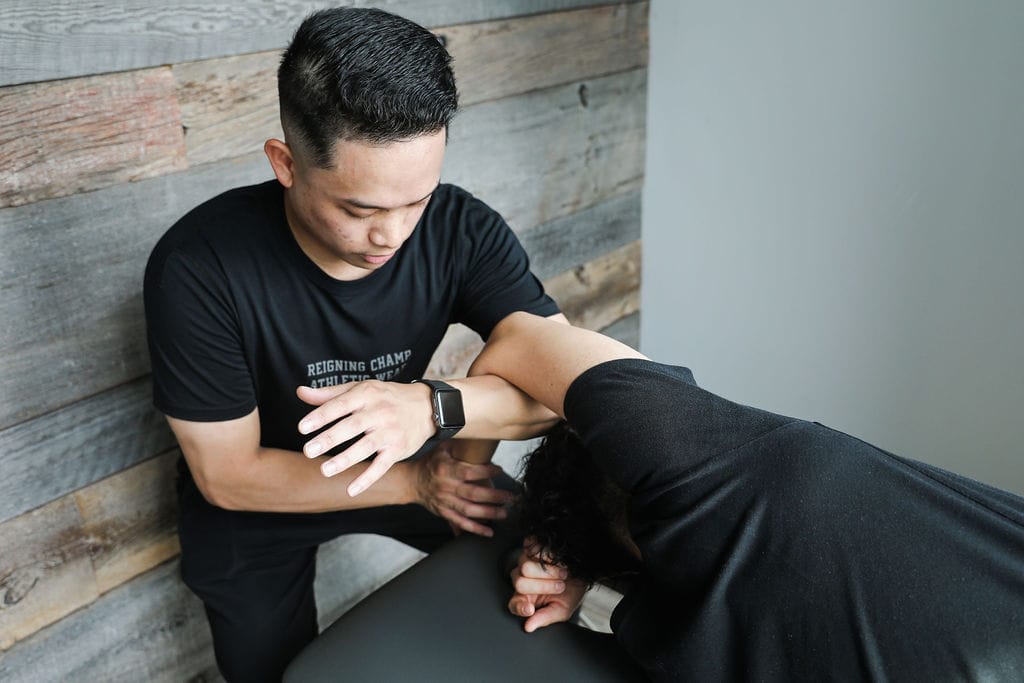
What is Deep Tissue Massage?
Deep tissue massage is a type of massage therapy that focuses on the deeper layers of muscle and connective tissue. It is especially beneficial for individuals who suffer from chronic pain, muscle tension, or are recovering from an injury. This technique involves the use of slow, deliberate strokes and deep pressure to target specific areas of tension and tightness.
What is Swedish Massage?
Swedish massage is a popular and widely practiced form of massage therapy known for its gentle and relaxing techniques. It focuses on promoting overall relaxation, improving blood flow, and relieving muscle tension. Swedish massage is an excellent choice for those new to massage therapy or looking for a general wellness treatment.
What is the difference between Deep Tissue Massage and Swedish Massage?
Swedish Massage:
- Relaxation: Promotes overall relaxation and reduces stress.
- Circulation: Enhances blood flow and oxygen delivery.
- Muscle Relief: Eases muscle tension and soreness.
- Flexibility: Improves range of motion and flexibility.
- General Wellness: Suitable for maintaining overall health and well-being.
Deep Tissue Massage:
- Pain Relief: Addresses chronic pain and conditions such as lower back pain and neck pain.
- Muscle Tension: Releases deeper layers of muscle tension and knots.
- Injury Recovery: Aids in rehabilitation from injuries by promoting healing and reducing scar tissue.
- Posture Improvement: Corrects muscle imbalances and postural issues.
- Specific Problem Areas: Focuses on targeted areas rather than the whole body.
What are some other types of Massage therapy?
1. Sports Massage
- Focus: Enhances athletic performance and recovery.
- Techniques: Combines Swedish massage, deep tissue, and stretching techniques.
- Benefits: Reduces muscle soreness, improves flexibility, and prevents injuries.
- Ideal For: Athletes and active individuals.
2. Trigger Point Therapy
- Focus: Relieves pain by targeting specific trigger points.
- Techniques: Applies direct pressure to trigger points (knots in the muscles).
- Benefits: Reduces localized pain and referred pain in other areas.
- Ideal For: People with chronic pain and tension.
3. Shiatsu
- Focus: Balances the body’s energy flow.
- Techniques: Uses finger pressure on specific points along the body’s meridians.
- Benefits: Promotes relaxation, reduces stress, and improves energy flow.
- Ideal For: Individuals seeking holistic health benefits and stress relief.
4. Reflexology
- Focus: Stimulates reflex points on the feet, hands, or ears.
- Techniques: Applies pressure to specific points believed to correspond to other body parts.
- Benefits: Enhances overall health and well-being, relieves stress, and improves circulation.
- Ideal For: People looking for non-invasive therapy and overall wellness.
5. Prenatal Massage
- Focus: Supports the health and well-being of pregnant women.
- Techniques: Gentle techniques to relieve pregnancy-related discomfort.
- Benefits: Reduces back pain, improves sleep, and decreases stress and anxiety.
- Ideal For: Pregnant women experiencing discomfort and seeking relaxation.
6. Hot Stone Massage
- Focus: Deep relaxation and muscle tension relief.
- Techniques: Uses heated stones placed on the body and integrated into massage strokes.
- Benefits: Enhances relaxation, improves circulation, and alleviates muscle stiffness.
- Ideal For: Individuals looking for a deeply relaxing experience.
7. Thai Massage
- Focus: Combines acupressure, stretching, and assisted yoga postures.
- Techniques: Performed on a mat, involves rhythmic pressure and stretching.
- Benefits: Increases flexibility, relieves muscle tension, and boosts energy levels.
- Ideal For: People seeking an active and invigorating massage experience.
8. Lymphatic Drainage Massage
- Focus: Stimulates the lymphatic system to remove toxins and waste.
- Techniques: Gentle, rhythmic strokes and light pressure.
- Benefits: Reduces swelling, improves immune function, and detoxifies the body.
- Ideal For: Individuals with lymphedema, post-surgery recovery, or those wanting detoxification.
9. Craniosacral Therapy
- Focus: Works on the craniosacral system to relieve tension.
- Techniques: Gentle touch to manipulate the skull and sacrum.
- Benefits: Reduces stress, alleviates pain, and improves nervous system function.
- Ideal For: People with chronic pain, headaches, or stress-related conditions.
10. Aromatherapy Massage
- Focus: Enhances the massage experience using essential oils.
- Techniques: Combines Swedish or other massage techniques with aromatherapy.
- Benefits: Promotes relaxation, reduces stress, and improves mood.
- Ideal For: Individuals seeking relaxation and mood enhancement.
Click here to book an appointment with a massage therapist at one of our eight locations.
- Massage therapy Etobicoke – Triangle Physiotherapy Etobicoke
- Oakville Massage Therapy Clinic – Triangle Physiotherapy Oakville
- Massage Therapy North York – Triangle Physiotherapy North York
- Mississauga Massage Therapy Clinics – Triangle Physiotherapy Mississauga
- Downtown Massage Therapy Clinics – Triangle Physiotherapy King West
- Uptown Massage Therapy Clinics – Triangle Physiotherapy Lawrence Park
- Massage Therapy Clinic Downtown Toronto – Triangle Physiotherapy Queens Quay
- RMT Mississauga – Triangle Physiotherapy Erin Mills
Whether you choose deep tissue or Swedish massage, both can offer significant benefits for relaxation and pain relief. If you’re looking for expert advice on which massage therapy is best for you, consider visiting a physiotherapy clinic in Etobicoke, Oakville, North York, Toronto, Lawrence Park, Queens Quay, Erin Mills, Mississauga, or Liberty Village. Professional physiotherapists and massage therapists in these areas can provide the right treatment to help you achieve your wellness goals.
What is the difference between a physiotherapist, massage therapist, and chiropractor?
Which practitioner is the best to see?
This is one of the most common questions that we get asked! Let’s dive in and learn more about how each of these practitioners can make a difference to your health.
What are the similarities between physiotherapists, massage therapists, and chiropractors?
- They treat musculoskeletal conditions – soft tissue (muscles, ligaments, tendons), bones, or the nervous system.
- All three are regulated professions – you cannot call yourself an RMT, chiropractor, or physiotherapist unless you are registered with their regulatory College.
- They all have specialized training – Physiotherapists at a recognized university, Chiropractors at a recognized Chiropractic College, and RMTs at a recognized Massage therapy course.
- All three have to pass exams administered by their regulatory board.
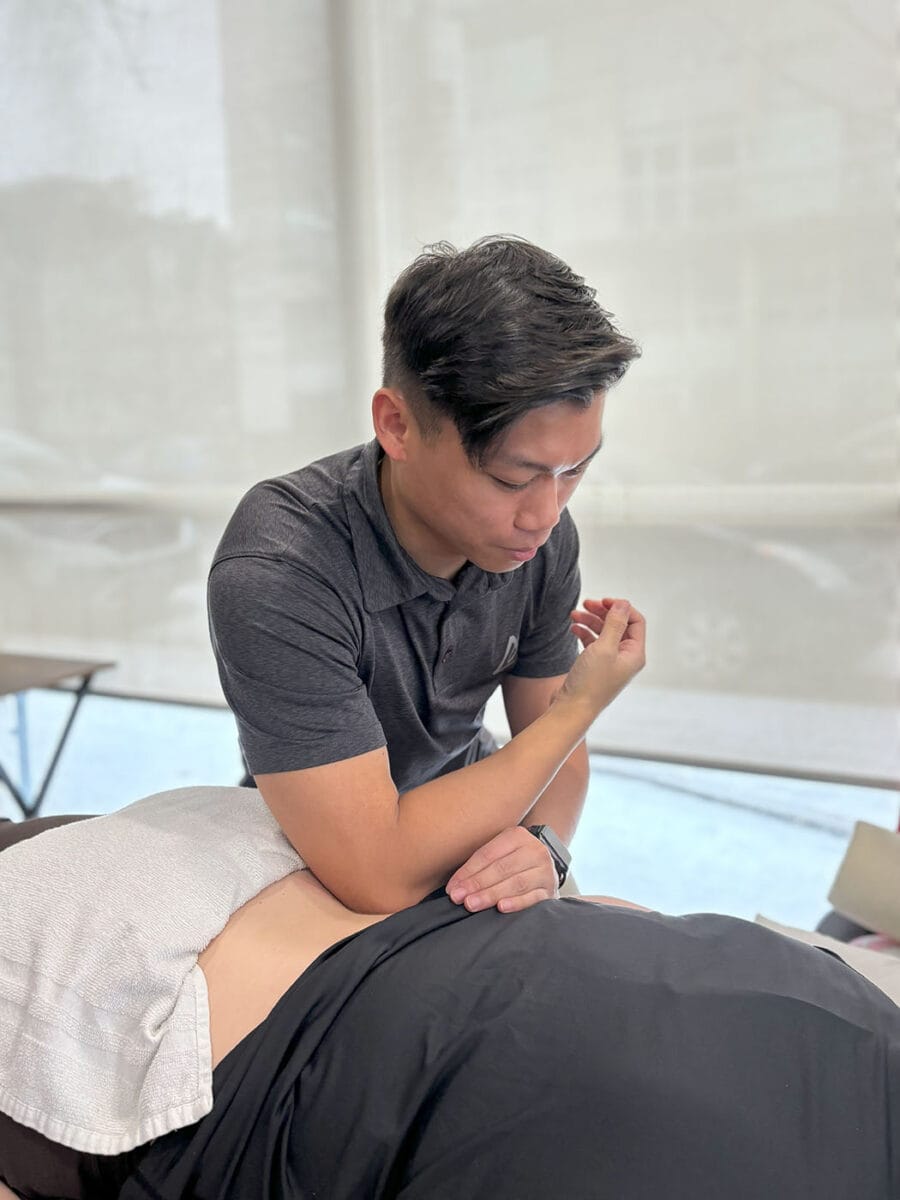
What does a Chiropractor do?
Chiropractic is a licensed healthcare profession that emphasizes the body’s ability to heal itself. Treatment typically involves manual therapy, often including spinal manipulation which helps restore joint function.
What does an RMT do?
An RMT, or Registered Massage Therapist, is a licensed healthcare professional who specializes in providing therapeutic massage treatments. They are trained to assess and treat various musculoskeletal conditions and injuries using hands-on techniques to manipulate muscles, tendons, ligaments, and other soft tissues of the body.
What does a physiotherapist do?
You should consider seeing a physiotherapist when you’re experiencing pain or discomfort, or have mobility issues that affect your daily activities and quality of life. Physiotherapists are healthcare professionals trained to diagnose and treat a wide range of musculoskeletal and movement-related conditions. They can also help with vestibular rehabilitation and pelvic health issues.
Physiotherapists can look at alignment but they also test joint mobility, muscle strength, muscle flexibility, nerve function, posture, and movement patterns. They restore movement and improve pain predominantly through exercise rehabilitation, postural re-training, and lifestyle advice, but also use hands-on techniques.
Can I see all three of these practitioners?
Absolutely! All three practitioners work collaboratively to get you the best possible outcomes and help you reach your health goals.
How do I book an appointment at a Triangle Physiotherapy Clinic near me?
Click HERE to book an appointment with a physiotherapist, RMT or chiropractor at one of our eight locations.
- Physiotherapy Etobicoke – Triangle Physiotherapy Etobicoke
- Oakville Physiotherapy Clinic – Triangle Physiotherapy Oakville
- Physiotherapy North York – Triangle Physiotherapy North York
- Mississauga Physiotherapy Clinics – Triangle Physiotherapy Mississauga
- Downtown Physiotherapy Clinics – Triangle Physiotherapy King West
- Uptown Physiotherapy Clinics – Triangle Physiotherapy Lawrence Park
- Physiotherapy Clinic Downtown Toronto – Triangle Physiotherapy Queens Quay
- Physiotherapy Clinics Mississauga – Triangle Physiotherapy Erin Mills
Choosing between a physiotherapist, massage therapist, or chiropractor depends on your specific health needs and goals. If you’re considering physiotherapy in Etobicoke, Oakville, North York, Toronto, Lawrence Park, Queens Quay, Erin Mills, Mississauga, or Liberty Village, skilled physiotherapists are available to help you decide on the best care plan for optimal health and recovery.
The holidays are around the corner, and so is all the pressure and stress that can tag along with them. Holiday stress is hard to avoid between work, family responsibilities, and a schedule packed with social commitments — but it’s easier to manage stress with massage therapy. Massage therapy can help you destress, unwind, and be ready to enjoy the holiday season.
How can massage therapy help with relieving holiday season stress?
Here are some ways in which massage can help alleviate holiday stress:
- Relaxation: Massage is known for its ability to induce relaxation. The physical manipulation of muscles helps release tension and promotes a sense of calm. This can be particularly beneficial during the hectic holiday season when stress levels tend to be higher.
- Reduced Muscle Tension: The physical demands of holiday preparations, such as shopping, cooking, and decorating, can lead to muscle tension and discomfort. Massage can target specific areas of tension, helping to release tight muscles and improve flexibility.
- Improved Sleep: The holiday season can disrupt regular sleep patterns due to increased activities and stress. Massage has been shown to improve sleep quality by promoting relaxation and reducing anxiety. Better sleep can contribute to overall well-being.
- Stress Reduction: Massage therapy has been linked to a reduction in stress hormones such as cortisol. Regular massage sessions can help regulate stress levels and promote a sense of well-being.
- Enhanced Mood: Massage stimulates the release of endorphins, the body’s natural feel-good chemicals. This can help improve mood and reduce feelings of anxiety or depression, which can be exacerbated during the holiday season.
- Increased Body Awareness: Massage encourages mindfulness and awareness of the body. Focusing on the present moment can help individuals let go of worries about the past or future, promoting a sense of peace and tranquility.
- Improved Circulation: The physical manipulation of muscles during massage promotes better blood circulation. Improved circulation can help reduce inflammation, support the immune system, and contribute to overall health.
- Time for Self-Care: The holiday season often involves taking care of others, which can leave little time for self-care. Scheduling a massage provides dedicated time for self-nurturing, allowing individuals to prioritize their well-being.
- Human Connection: Massage therapy involves human touch, which can have a positive impact on emotional well-being. The connection with a massage therapist can provide a sense of comfort and support.
- Mind-Body Connection: Massage emphasizes the interconnectedness of the mind and body. Taking the time for a massage can help individuals reconnect with their bodies, fostering a holistic approach to health.

How do I book an appointment with a massage therapist near me?
Click HERE to book an appointment with a physiotherapist or chiropractor at one of our eight locations.
- Massage Therapy Etobicoke – Triangle Physiotherapy Etobicoke
- Oakville Massage Therapy Clinic – Triangle Physiotherapy Oakville
- RMT North York – Triangle Physiotherapy North York
- Mississauga Massage Therapy Clinics – Triangle Physiotherapy Mississauga
- Downtown RMT Clinics – Triangle Physiotherapy King West
- Massage Therapy Yonge and Eglinton – Triangle Physiotherapy Lawrence Park
- RMT Downtown Toronto – Triangle Physiotherapy Queens Quay
- RMT Mississauga – Triangle Physiotherapy Erin Mills
Massage therapy is a great way to relieve stress during the holiday season, reduce muscle tension, and promote relaxation. If you’re looking for professional physiotherapy services to complement your massage therapy and enhance your overall well-being, consider clinics in physiotherapy Etobicoke, Oakville, North York, Toronto, Lawrence Park, Queens Quay, Erin Mills, Mississauga, and Liberty Village. These clinics offer expert care and personalized treatment plans to support your health and relaxation needs.
Back pain is one of the most common ailments we see in our practice.
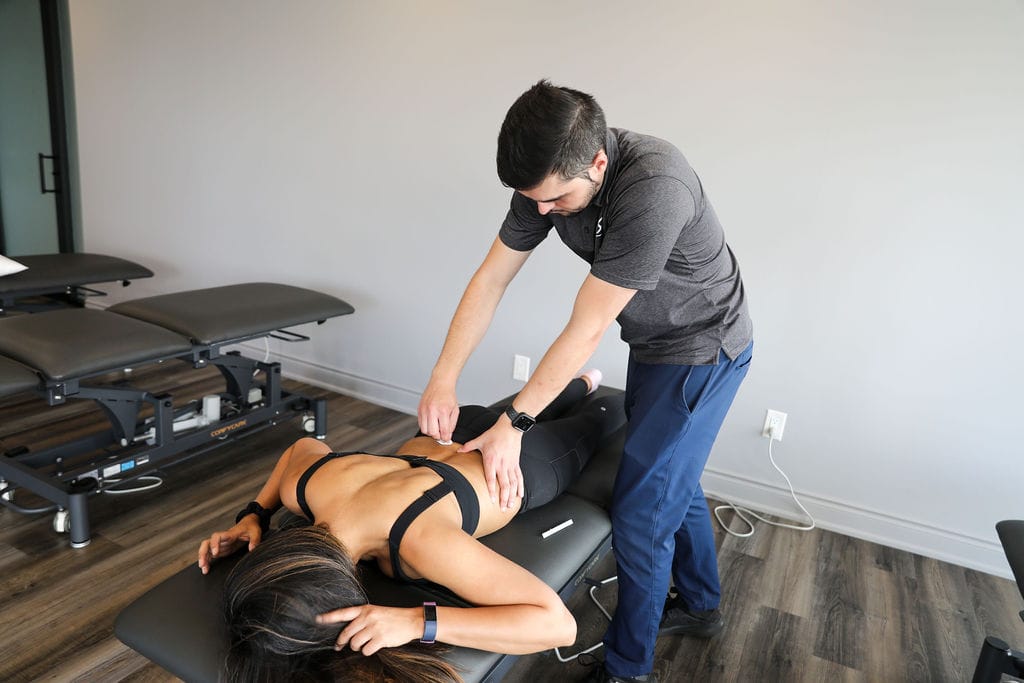
Here are some self-care measures you can consider to manage or prevent recurrence:
- Rest: Give your back a break by avoiding activities that may exacerbate the pain. However, avoid prolonged bed rest, as it can lead to stiffness and muscle weakness. Gentle movement and stretching are usually better than complete immobility.
- Ice and Heat: Apply ice packs to the affected area for the first 48 hours to reduce inflammation, then switch to heat therapy (e.g., heating pads) to relax tight muscles. Use each for 15-20 minutes at a time.
- Over-the-Counter Pain Relief: Non-prescription pain relievers such as ibuprofen (Advil) or acetaminophen (Tylenol) can help alleviate pain and reduce inflammation. Follow the recommended dosage and consult a healthcare professional if you have concerns.
- Exercise: Gentle, low-impact exercises can help strengthen your back and improve flexibility. Activities like swimming, walking, or yoga can be beneficial. Consult a physical therapist for guidance on appropriate exercises.
- Posture: Maintain good posture when sitting and standing to reduce strain on your back. Use ergonomic chairs and accessories if needed, and avoid prolonged periods of sitting.
- Proper Lifting Technique: When lifting heavy objects, bend at your knees and hips instead of your waist, and use your legs to lift while keeping the object close to your body.
- Core Strengthening: Strengthening your core muscles (abdominals, obliques, and lower back) can provide better support for your spine. Pilates and specific core exercises can help with this.
- Sleep: Ensure you have a comfortable mattress and pillow that support your spine. Sleeping on your side with a pillow between your knees can help maintain proper alignment.
- Stress Reduction: Stress can contribute to muscle tension and pain. Techniques such as meditation, deep breathing exercises, and relaxation techniques may help manage stress.
- Weight Management: Maintaining a healthy weight can reduce the strain on your back and decrease the risk of back pain.
- Physiotherapy: A physical therapist can provide personalized exercises and techniques to address your specific back pain issues.
- Chiropractic Care or Massage Therapy: Some people find relief through chiropractic adjustments or therapeutic massages. Consult with professionals in these fields to see if it’s appropriate for your condition.
- Avoid Smoking: Smoking can impair blood flow to the spine and hinder the healing process.
If your back pain persists, worsens, or is accompanied by other concerning symptoms (such as numbness, tingling, weakness, or loss of bladder or bowel control), seek immediate medical attention. Always consult a healthcare provider before starting any new exercise or treatment regimen, especially if you have underlying health conditions or are taking medications. They can provide a more accurate diagnosis and recommend the best treatment options for your specific situation.
How do I book an appointment with a physiotherapist or chiropractor near me?
Click HERE to book an appointment with a physiotherapist or chiropractor at one of our eight locations.
- Physiotherapy Etobicoke – Triangle Physiotherapy Etobicoke
- Oakville Physiotherapy Clinic – Triangle Physiotherapy Oakville
- Physiotherapy North York – Triangle Physiotherapy North York
- Mississauga Physiotherapy Clinics – Triangle Physiotherapy Mississauga
- Downtown Physiotherapy Clinics – Triangle Physiotherapy King West
- Uptown Physiotherapy Clinics – Triangle Physiotherapy Lawrence Park
- Physiotherapy Clinic Downtown Toronto – Triangle Physiotherapy Queens Quay
- Physiotherapy Clinics Mississauga – Triangle Physiotherapy Erin Mills
“Relieving back pain requires a comprehensive approach that includes targeted physiotherapy. Triangle Physiotherapy offers expert services across the GTA, including Physiotherapy in Etobicoke, Oakville, North York, Toronto, Lawrence Park, Queens Quay, Erin Mills, Mississauga, and Liberty Village. Our experienced physiotherapists can help you find effective solutions to alleviate your back pain and improve your quality of life.”
A Massage Therapist can be an integral part of your healthcare team to help you relax, reduce muscle tension, and alleviate pain or discomfort through manual manipulation of soft tissues in the body.
To find the best massage therapist near you, you can follow these steps:
- Ask for recommendations: Start by asking your friends, family members, or colleagues if they can recommend a good massage therapist they have had a positive experience with. Personal recommendations are often reliable.
- Search online: Look up “massage therapy clinics near me”, and read their reviews online.
- Check credentials and qualifications: Make sure the massage therapist is registered with the College of Massage Therapists of Ontario.
- Consider specialization and modalities: Determine the type of massage you’re interested in or any specific needs you have, such as deep tissue massage, sports massage, or prenatal massage. Some therapists specialize in certain modalities, so look for those who offer the specific type of massage you desire.
- Contact and ask questions: Reach out to the clinic you’re considering and ask them questions about their experience, training, techniques, and any other concerns you may have. This can help you assess their knowledge and determine if they are a good fit for you.
- Consider location and convenience: Take into account the location of the massage therapist’s practice. Choose someone who is conveniently located, ensuring it’s not too far from your home or workplace, making it easier to schedule and attend appointments.
- Visit the therapist’s facility: If possible, visit the therapist’s facility before booking an appointment. Assess the cleanliness, ambiance, and overall atmosphere to ensure it aligns with your preferences and promotes relaxation.
- Trust your intuition: Trust your instincts when selecting a massage therapist. If something feels off or you don’t feel comfortable during the initial interactions, it may be best to continue your search for a therapist who puts you at ease.
FAQs About Finding a Massage Therapist Near You
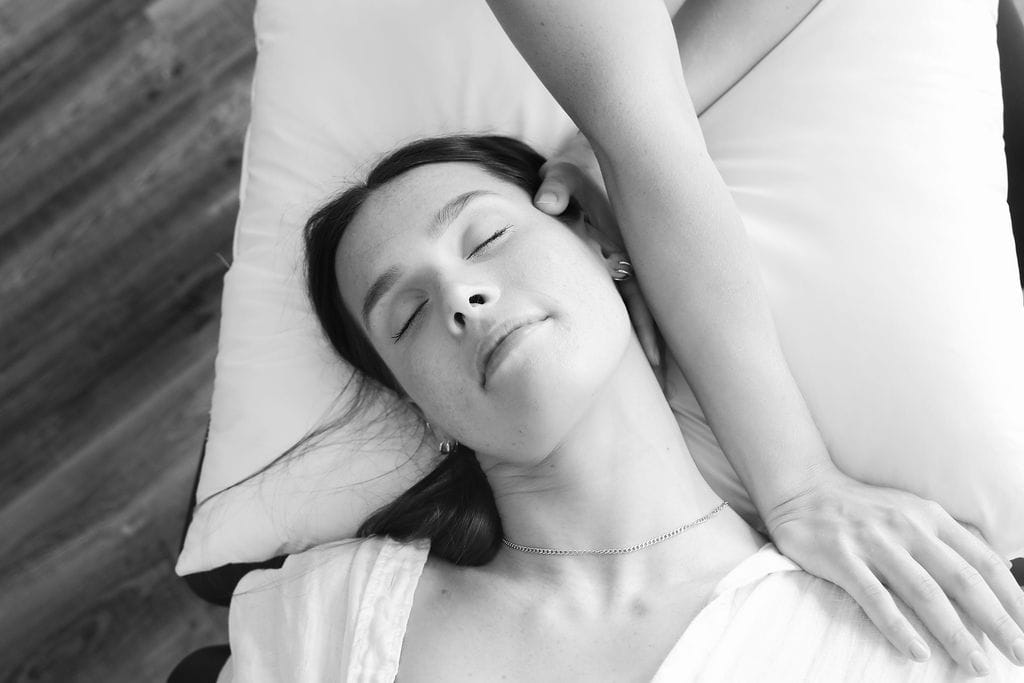
How often should I get a massage?
Regular massages can help you manage your stress and any other symptoms you may have. They can also help with pain relief, improve your flexibility and promote your overall well-being. Ideally, one session a week can help you maintain good health, but it is wise to ask your massage therapist for recommendations with regard to frequency.
What is the best duration for a massage?
Massage treatments range from 30-minute to 90-minute sessions. If you would like your entire body to be worked on, at least 60 minutes is recommended. A 30-minute session can suffice for a targeted area treatment.
Do you take off all your clothes for massage?
Most massage therapists prefer that you undress for your massage therapy session. You may request a gown if you wish but massage therapists are trained to drape their patients to maintain their privacy.
Is it rude to fall asleep during a massage?
Not at all, massage therapists are able to continue treating you even if you fall asleep. It is not rude, nor does it insult them in any way. Some might even take it as a compliment that they were able to relax you enough for you to fall asleep.
Should you talk during a massage?
As the client, you can choose to converse with your massage therapist, whenever you want. That being said, if you prefer peace and quiet and do not wish to talk during your session, feel free to let your therapist know.
A massage therapy clinic near me looks sketchy, how do I find out if it is a reputed clinic?
- Look up the clinic’s website and see if it looks respectable.
- Check for online reviews.
- Ask if the massage therapist is registered with the College of Massage Therapists of Ontario, ask for their name, and look them up on the College Register.
What is the most effective type of massage?
There are different types of massage techniques. A massage therapy treatment transmits dedication and care which can have profound effects on health and well-being by providing mental and physical relaxation.
- Relaxation Massage: A relaxation massage has a powerful effect on the nervous system that affects the whole body. It restores harmony to those who are stressed through careful manipulation of the muscles and joints.
- Deep Tissue Massage: A deep tissue massage aims to relieve chronic tension, through slow movements and deep pressure on contracted areas. A deep tissue massage provides profound relief with enduring effects in areas difficult to address with a more superficial muscle massage.
- Swedish Massage: This is the most common type of massage, characterized by long, gliding strokes, kneading, and circular movements. It aims to promote relaxation, improve circulation, and relieve muscle tension.
- Sports Massage: Primarily designed for athletes or individuals engaged in physical activities, sports massage helps prevent and treat sports-related injuries. It combines techniques from Swedish massage, deep tissue massage, and stretching to enhance performance, flexibility, and recovery.
- Hot Stone Massage: This type of massage involves placing smooth, heated stones on specific points of the body. The therapist may also use the stones to massage the body, providing a deep sense of relaxation and relieving muscle tension.
- Thai Massage: Also known as Thai yoga massage, it combines acupressure, stretching, and assisted yoga postures. The therapist uses their hands, knees, legs, and feet to apply rhythmic pressure and stretch the body, promoting flexibility and energy flow.
- Shiatsu Massage: Originating from Japan, Shiatsu massage applies finger pressure to specific points on the body to balance the body’s energy flow. It incorporates stretching and gentle joint manipulation techniques.
- Reflexology: This massage focuses on specific reflex points on the hands, feet, and ears that are believed to correspond to different organs and systems in the body. Pressure is applied to these points to promote relaxation and stimulate healing responses.
Is it rude not to tip a massage therapist?
A tip is never required at our clinics, however, it may be appreciated by your massage therapist. If you choose not to tip, by no means will it be considered rude.
However, in some settings like spas and hotel spas, it is considered a norm to tip your massage therapist.
Our More Locations
Physiotherapy Etobicoke | Physiotherapy Oakville | Physiotherapy North York | Physiotherapy Toronto | Physiotherapy Lawrence Park | Physiotherapy Mississauga | Physiotherapy Queens Quay | Physiotherapy Mississauga Erin Mills | Physiotherapy Liberty Village
How do I find a massage therapist near me?
We have 8 locations with registered massage therapists to help you. Book an Appointment today!
- RMT Etobicoke – Triangle Physiotherapy Etobicoke
- Registered Massage Therapy Oakville – Triangle Physiotherapy Oakville
- Massage Therapy North York – Triangle Physiotherapy North York
- Best RMT in Mississauga – Triangle Physiotherapy Mississauga
- RMT Downtown Toronto – Triangle Physiotherapy King West
- Uptown Toronto RMT – Triangle Physiotherapy Lawrence Park
- RMT near me in Downtown Toronto – Triangle Physiotherapy Queens Quay
- Mississauga RMT near me – Triangle Physiotherapy Erin Mills
Finding the best massage therapist involves considering factors like qualifications, experience, and the range of services offered. If you’re also looking for professional physiotherapy services to complement your massage therapy, there are excellent clinics in physiotherapy Etobicoke, Oakville, North York, Toronto, Lawrence Park, Queens Quay, Erin Mills, Mississauga, and Liberty Village. These locations provide expert care and personalized treatment plans to help you achieve overall wellness and recovery.
Golfer’s elbow and Tennis Elbow are both tendonitis. The difference is Golfer’s elbow occurs on the inner side of the elbow while Tennis Elbow occurs on the outer side of the elbow. Tennis elbow, also known as lateral epicondylitis is the inflammation of the tendon that connects the forearm muscles to a bony prominence on the outside of the elbow known as the lateral epicondyle. Golfer’s elbow, on the other hand, is known as medial epicondylitis because the inflammation is on the tendons which are attached to the medial epicondyle.
How Is Tennis Elbow Diagnosed?
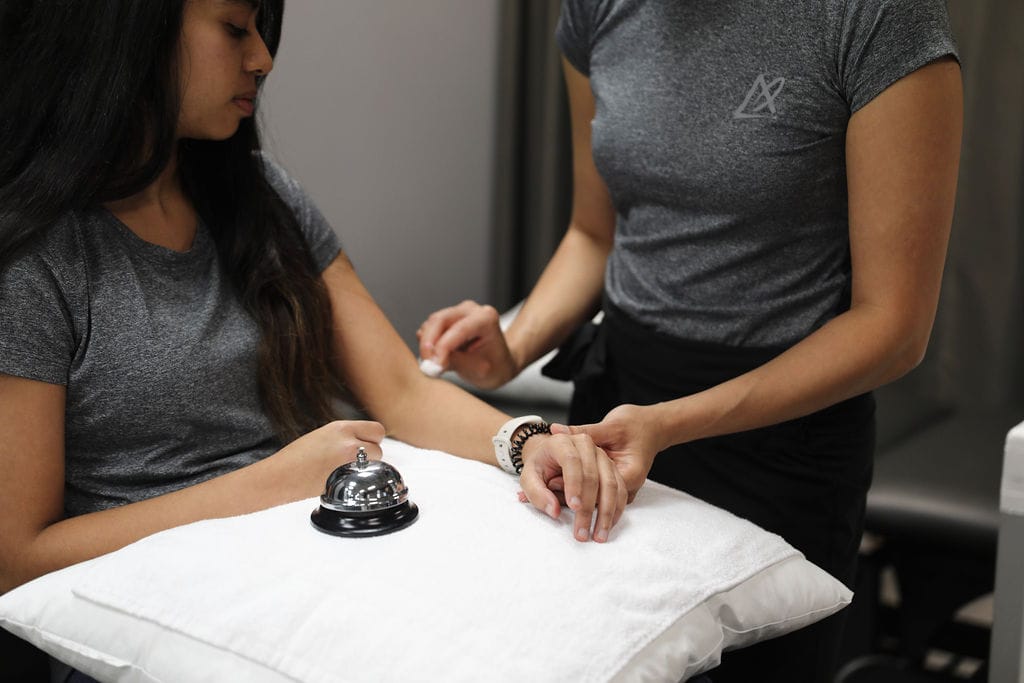
Your physiotherapist will evaluate tennis elbow by reviewing your medical history, performing and reviewing your medical history. A doctor may recommend a X-ray, EMG or MRI to assess the severity of the condition.
A physiotherapist can also conduct a detailed assessment of your elbow and the surrounding structures in order to create a personalized treatment plan for you. Special tests such as Cozen’s and Mills Test can also be used to diagnose Tennis elbow.
What are the complications of a Tennis Elbow?
Complications of Tennis elbow or lateral epicondylitis may include tendon rupture, recurrence of the injury, chronic pain, nerve entrapment in the forearm, and failure to improve despite both nonsurgical and no surgical treatment.
Cause of Tennis Elbow and Treatment
What causes a Tennis elbow and who might get a Tennis Elbow?
Some causes of Tennis elbow are:
- weak wrist muscles,
- use of tennis racquets that are too short,
- weakened muscles of the shoulder and wrist,
- repetitive hand motions,
- poor tennis technique,
- frequent use of hand tools,
- lifting heavy objects, and
- excessive gripping activities.
Despite the name, Tennis elbow is not only for tennis players although they tend to often develop tennis elbow because of the repetitive muscle use and gripping activities the sport entails. People whose professions involve repetitive use of the wrist and forearm are more likely to develop lateral epicondylitis.
Some professions, such as painters, dentists, plumbers, carpenters, musicians, and cooks, may develop Tennis elbow which can also be caused by the repetitive use of a keyboard and mouse.
What Is The Best Treatment For Tennis Elbows?
The majority of tennis elbow cases can be successfully treated without surgical intervention. How a tennis elbow is treated may vary depending on which medical professional you choose to see.
Research has shown that physiotherapy is the most effective treatment of the Tennis elbow.
Tennis Elbow Physiotherapy Treatment
- Therapeutic Ultrasound
- Acupuncture
- Tennis elbow treatment exercises
- Deep tissue massage
- Shockwave therapy
- Taping or brace
- TENS
- Modified activities
- Hot and cold packs
How does massage help heal Tennis elbow?
Tennis Elbow Massage Treatment helps improve circulation, stimulate collagen production, and increases mobility in the affected area.
What Can I Do To Prevent Tennis Elbow?
There are many ways to prevent Tennis elbow such as:
- Stretching regularly.
- Strengthening of the forearm muscles.
- Modifying activities that contribute to pain.
- Warming up before playing tennis and other sports and ensuring the stability of the wrist.
What are some Tennis elbow exercises which can be done at home to help prevent recurrence?
Specific Tennis elbow exercises to strengthen as well as stretch the muscles that are attached to the injured tendon will certainly help speed up healing which then increases its resistance to repetitive stress… Some of these Tennis elbow treatment exercises are Stress ball squeeze, finger stretch, wrist extension, flexion stretch, forearm extension, flexion, supination, and pronation strengthening exercises.
Are there any natural Tennis elbow treatments I can do at home while I wait to see a physiotherapist?
Resting and avoiding activities that aggravate your pain can be beneficial. You may also try to apply an ice pack for 15 mins three times a day.
What is the best treatment for chronic Tennis elbow?
The most effective treatment for chronic tennis elbow has always been physiotherapy and exercise. If physiotherapy does not fully heal it, however, steroid injections, braces, and surgery may also help.
Our physiotherapists in Toronto, Midtown Toronto, Mississauga, North York and Oakville can help you with tennis elbow. Book your appointment here.
“Effectively treating tennis elbow and golfer’s elbow requires specialized physiotherapy care. Triangle Physiotherapy offers expert services across the GTA, including Physiotherapy in Etobicoke, Oakville, North York, Toronto, Lawrence Park, Queens Quay, Erin Mills, Mississauga, and Liberty Village. Our experienced physiotherapists can help you recover from elbow pain and regain strength with personalized treatment plans.”

